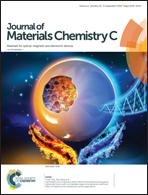Phosphorene nano-heterostructure based memristors with broadband response synaptic plasticity†
Abstract
Motivated by the biological neuromorphic system with a high degree of connectivity to process huge amounts of information, light-triggered electronic synapses are expected to pave the way for overcoming the von Neumann bottleneck for non-conventional computing. Here, a light-triggered electronic synapse based on solution-processed ZnO–phosphorene nanoparticles (ZP NPs) with an in situ fabricated heterojunction is demonstrated. In situ Kelvin probe force microscopy (KPFM) and conductive atomic force microscopy (CAFM) have been employed to investigate the operation principle of the memristor. The essential synaptic functions of learning and memory of the bio-synapse have been emulated, including potentiation and depression under positive and negative pulse trains, paired-pulse facilitation (PPF), spike-rate-dependent plasticity (SRDP), spike-timing-dependent plasticity (STDP) and short-term potentiation (STP) to long-term potentiation transition (LTP). The well-arranged pn junction inside the ZP NPs arouses the multiple wavelength response and fast separation of photogenerated excitons, which serves as the basis for broadband optically-mediated plasticity. The experimental results confirm that ZP nanoparticles could be promising key components for mimicking biological synaptic behaviors with light stimulation, which is of great importance for the further development of artificial light triggered neural systems.



 Please wait while we load your content...
Please wait while we load your content...